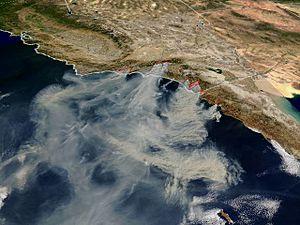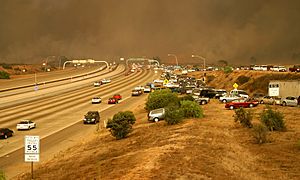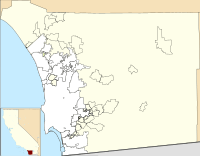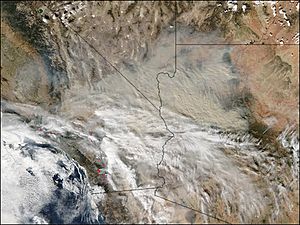Cedar Fire facts for kids
Quick facts for kids Cedar Fire |
|
|---|---|

A dozen simultaneous wildfires in October 2003; the Cedar Fire is the group of large red dots right of center.
|
|
| Location | San Diego County, California |
| Coordinates | 33°01′00″N 116°41′00″W / 33.016667°N 116.683333°W |
| Statistics | |
| Cost | At least $1.331 billion (2003 USD) |
| Date(s) | October 25, 2003 – December 5, 2003 |
| Burned area | 273,246 acres (1,106 km2) |
| Cause | Signal fire |
| Buildings destroyed |
|
| Deaths |
|
| Non-fatal injuries | 113 |
| Map | |
The Cedar Fire was a huge and very damaging wildfire. It burned over 273,246 acres (1,106 km2) of land. This happened in San Diego County, California. The fire raged during October and November 2003.
Strong, dry winds called Santa Ana winds made the fire spread super fast. It moved at about 3,600 acres (15 km2) every hour! By November 4, the fire was mostly under control. It had destroyed 2,820 buildings, including 2,232 homes. Sadly, 15 people died, including one firefighter. Small fires kept burning until December 5, 2003. That's when the Cedar Fire was completely out.
This fire is still one of the biggest wildfires in California's history. As of 2022, it's the ninth-largest modern wildfire in the state. It's also known as the sixth-deadliest and fourth-most destructive. The fire caused over $1.3 billion in damages.
Contents
How the Fire Grew


The Cedar Fire started in the Cuyamaca Mountains. This area is part of the Cleveland National Forest. It was first reported at 5:37 p.m. on October 25, 2003. The location was south of Ramona in central San Diego County. At that time, many other wildfires were already burning in Southern California.
Firefighters quickly responded to the new blaze. Within minutes, many fire engines and crews were on their way. A San Diego County Sheriff's Department helicopter also spotted the fire. It was on a rescue mission. Another helicopter with a special water bucket was sent. But a Forest Service chief stopped the water drop. This was because of a policy about not flying close to sunset. Many people later criticized this decision.
First Hours of the Fire
Strong easterly Santa Ana winds began blowing after midnight. The fire quickly burned about 5,319 acres. By 3:00 a.m., 62,000 acres (250 km2) had burned. The fast-moving fire killed 12 people overnight. They lived in Wildcat Canyon and Muth Valley. They had little warning the fire was coming. The fire also destroyed 39 homes on the Barona Indian Reservation.
In just a few hours, the Cedar Fire moved southwest over 30 miles (48.3 km). It burned over 100,000 acres (400 km2). The fire spread as fast as 6,000 acres (24 km2) per hour. It even crossed big highways like Interstate 15. By noon on October 26, the fire was burning hundreds of homes. This happened in the Scripps Ranch community of San Diego.
Fire Spreads to More Towns
On October 26, the fire reached Alpine, Harbison Canyon, Lake Jennings, and Crest. It burned hundreds more homes there. These areas had been hit hard by the Laguna Fire 33 years earlier. By October 28, the strong Santa Ana winds calmed down. The fire then turned east. It burned another 114,000 acres (460 km2).
The entire community of Cuyamaca was destroyed. Most of nearby Cuyamaca Rancho State Park also burned. More than 500 homes around the town of Julian were lost.
Firefighters Face Danger
On October 29, a group of firefighters tried to save a house. This was in Riverwood Estates, near Santa Ysabel. The fire trapped them. One firefighter died. Another firefighter was badly hurt. Two others also got injured. Firefighters finally had the Cedar Fire fully contained on November 3. The fire was completely out on December 5.
Effects of the Fire
After the 2003 firestorm, California Governor Arnold Schwarzenegger declared a state of emergency. He called in the National Guard to help. President George W. Bush also declared several counties disaster areas. These included Los Angeles, San Bernardino, San Diego, and Ventura counties. Air travel in the region was also affected. This was because of problems with air traffic control radar.
San Diego's Qualcomm Stadium was used as a place for people to evacuate. This meant the NFL had to move a football game. The Monday Night Football game on October 27 was between the San Diego Chargers and Miami Dolphins. It was moved to Sun Devil Stadium in Tempe, Arizona. The decision to move the game was made less than 24 hours before it started. Admission to the game was free.
How the Fire Started
Investigators found out that the fire was started by Sergio Martinez. He was a hunter from West Covina, California. Martinez had gotten lost in the area. He first told investigators he fired his rifle to get attention. He said the shot caused the fire. But he later changed his story. He admitted he started the fire on purpose to signal rescuers.
Martinez gathered sticks and brush. He then lit them. But he quickly lost control of the fire. This was because of the heat, low humidity, and dry plants around him.
Martinez was later sentenced for starting the fire. He had to do community service. He also had to pay some money to help cover damages.
People Who Died
Fifteen people died because of the Cedar Fire. This included one firefighter. One survivor, Rudy Reyes, was burned over about 70 percent of his body. Many people who died were trapped by the flames. Winds blowing at 60-mile-per-hour (97 km/h) made the fire move too fast for them to escape.
Thirteen of the people who died were killed in the first 24 hours. At least 10 people were trapped in their cars. They were trying to drive away from the flames. Some victims were so badly burned that they were identified by their pets' tags. On October 29, fire surrounded an engine crew from the Novato Fire District. This happened near the town of Julian. Engineer Steven Rucker died. The three other crew members were able to find shelter in a house.
Images for kids








